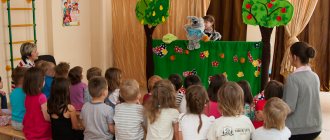The development of the concept of human rights led to the fact that the rights of the child were allocated to a special category. By the beginning of the 21st century, a system for protecting children’s rights at the international level, supported by relevant legal documents, had developed in the world. The fundamental international documents on the protection of children's rights are the Universal Declaration of Human Rights and the Convention on the Rights of the Child. Practical support of the principles enshrined in these documents is the main task of the state in Russia.
We bring to your attention materials for conducting a class hour “Children’s Rights” for students in grades 6-7.
Author: T. V. Ryabtseva
Recommendations for working with the presentation of the class hour “The Rights of the Child” for students in grades 6–7
Lesson option [PDF] [DOCX]
Presentation [PDF] [PPTX]
Student Materials (worksheet) [PDF] [DOCX]
Teacher's materials [PDF] [DOCX]
Quiz [PDF] [DOCX]
Goal: formation of legal consciousness of students, their legal culture.
Tasks:
- develop a general understanding of the rights of the child as enshrined in the Declaration of the Rights of the Child and the Convention on the Rights of the Child;
- promote the development of students’ interest in issues of legal education, their determination of their attitude to law as a public value;
- help schoolchildren formulate their own ideas about modern legal and moral values of society;
- contribute to the development of students’ competencies in protecting the rights, freedoms and legitimate interests of the individual.
The methodological material is advisory in nature; The class teacher, taking into account the characteristics of each class, can vary the tasks, their number, and change the stages of the class hour.
Exercise.
Watch the video. What do you think the phrase “Children have the right to rights” means?
Formulate the topic and main questions of the lesson.
Today we will talk about the rights of the child.
Why do you think this topic is important and relevant?
Every person should know their rights. Minor children are no exception to this rule. From birth, a child is a full-fledged citizen of his country, is endowed with rights, and with age acquires responsibilities.
Every year on November 20, World Children's Rights Day is celebrated.
On November 20, 1959, the UN General Assembly adopted the Declaration of the Rights of the Child , containing 10 essential principles for ensuring the protection and welfare of children.
On November 20, 1989, the UN General Assembly adopted the Convention on the Rights of the Child , an important document regulating the protection of children's rights throughout the world. The Convention is not a list of children’s rights, but a list of the obligations that states have assumed to protect these rights.
Questions:
1. Why do you think there was a need to separate children's rights into a separate category?
2. Why, 30 years after the adoption of the Declaration, was it necessary to adopt another document on the rights of the child - the Convention?
(The Declaration is not binding, it is a recommendation that proclaims the basic principles and program provisions. A convention is an agreement on a special issue that is binding on those states that have joined it. By signing the convention, states declare their obligation to comply with these provisions and in case of non-compliance they are responsible to the international community).
The UN General Assembly (United Nations) recommended that all countries introduce the practice of celebrating World Children's Rights Day as a day of world brotherhood and mutual understanding among children. She invited governments to celebrate this day on any day that each of them considers appropriate.
Task No. 1. (example: all tasks in the appendix)
Read the text and answer the questions.
Questions:
- How is World Children's Day celebrated in different countries?
- What do different nations have in common in the traditions of celebrating this day? Explain your answer.
Task No. 2.
There is a symbol of International Children's Day - a flag recognized today in more than thirty countries around the world.
Consider the image of the flag. Guess what the elements of the flag symbolize.
For reference.
Task No. 3.
Read Article 1 of the Convention on the Rights of the Child. How can one explain this length of childhood?
Read Article 6 of the Convention on the Rights of the Child.
Based on the wording of the article, continue the phrase: “The Convention is not a list of children’s rights, but a list of those obligations ...”
(For example, ... which states have assumed to protect these rights.)
Task No. 4.
Get acquainted with some articles of the Convention on the Rights of the Child. Can you guess what measures are being taken in the states that have acceded to the Convention to guarantee the observance of these rights?
- Inalienable right to life (Article 6).
- The right to a name, citizenship, preservation of one’s individuality (Articles 7, 8).
- The right to freely express one’s opinion (Article 13).
- Access to information (Article 17).
- Children with disabilities have the right to special care (Article 23).
- Right to health care (Article 24).
- The child’s right to education (Article 28).
- The right to rest and leisure (Article 31).
- The right to protection from economic exploitation (Article 32).
Additional material: full text of the Convention on the Rights of the Child.
In what cases can some children's rights be limited? Give examples.
(For example, the right to freedom to seek, receive and impart information may be subject to restrictions in order to respect the rights or reputations of others or to protect national security or public order, or public health or morals.)
Under no circumstances can the right to life be limited!
Task No. 5.
Familiarize yourself with the proposed situations and the content of the articles of the Convention on the Rights of the Child. Match the child's right with the proposed situation. Explain your choice.
The Russian Federation acceded to the Convention on the Rights of the Child in 1990. Children's rights are reflected in the Constitution of the Russian Federation and the Family Code of the Russian Federation; In 1998, the Federal Law “On Basic Guarantees of the Rights of the Child in the Russian Federation (No. 124-FZ) and other legal acts was adopted. One of these laws is Federal Law No. 273-FZ of December 29, 2012 “On Education in the Russian Federation.”
Task No. 6.
Read excerpts from articles of the Law “On Education in the Russian Federation”. What two groups can these articles be divided into? Explain your answer. Draw a conclusion.
Game-exercise “Legal pictograms”
Work in groups.
A pictogram (picture letter) is a symbol that conveys information about an object or idea through illustration.
Task No. 7.
After studying the articles of the Convention on the Rights of the Child, select two that attracted your special attention and “encode” them in the drawing. Ask another group to determine the content of the article you have chosen.
Task No. 8.
Express in one sentence the essence of the Convention on the Rights of the Child.
(For example: as much respect as possible for the child, his rights, care for him, love for him.)
Conversation with parents about the rights of a preschool child
Consultation for parents
Prepared by senior teacher I.I. Sinogina
“On the rights of a preschool child”
Dear parents! We want to touch upon a very important and pressing issue related to the protection of the rights and dignity of a small child, and also consider the rights and responsibilities of parents in relation to the child.
Preschool childhood is a unique period in a person’s life, during which health is formed and personality develops. At the same time, this is a period during which the child is completely dependent on the adults around him - parents and teachers. The health of children and their full development is largely determined by the effectiveness of protecting their rights. A child deprived of care and attention has no second opportunity for normal growth and healthy development.
“The world's children are innocent, vulnerable and dependent,” states the World Declaration on the Survival, Protection and Development of Children. In accordance with this provision, the international community for the protection of children's rights has adopted important documents designed to ensure the protection of children's rights throughout the world:
The main UNICEF international documents related to children's rights include:
Declaration of the Rights of the Child (1959);
UN Convention on the Rights of the Child (1989);
World Declaration on the Survival, Protection and Development of Children (1990).
The Declaration of the Rights of the Child is the first international document. The 10 principles set out in the Declaration proclaim the rights of children: to a name, citizenship, love, understanding, material security, social protection and the opportunity to receive education, develop physically, morally and spiritually in conditions of freedom and dignity.
The Declaration pays special attention to the protection of the child. Based on the Declaration of the Rights of the Child, an international document was developed - the Convention on the Rights of the Child.
The Convention recognizes that every child, regardless of race, color, sex, language, religion, political or other opinion, national, ethnic or social origin, has the legal right to:
- for education;
— for development;
- for defense
The Convention links the rights of the child with the rights and responsibilities of parents and other persons responsible for the lives of children, their development and protection, and provides the child with the right to participate in decisions affecting his present and future.
The Convention on the Rights of the Child is a legal document of high international standard and great pedagogical significance. It proclaims the child to be a full-fledged and full-fledged personality, an independent subject of law, and calls for building relationships between an adult and a child on moral and legal standards, which are based on genuine humanism, democracy, respect and careful attitude towards the child’s personality, his opinions and views.
“Protecting children's rights begins with respect for the fundamental provisions of the Convention on the Rights of the Child.”
A child is considered a person who has not reached the age of 18, unless by law he has become an adult earlier (Article 1).
All children are equal in their rights (Article 2). Children have the same rights regardless of gender, skin color, religion, origin, financial status and other differences.
The interests of the child must come first (Article 3). The state, when making decisions affecting the interests of children, takes into account the rights of the child in the first place.
Right to life (Article 6). No one can take the life of a child or make an attempt on his life. The state is obliged to ensure the survival and healthy development of the child to the maximum extent possible.
The right of the child to be cared for by his parents (Article 7). Every child has the right to a name and nationality at birth, as well as the right to know and be cared for by their parents.
The right to preserve one's individuality (Article 8). Each child is one of a kind; with all his features of appearance, character, name, family connections, dreams and aspirations.
Right to freedom of expression (Article 12, 13) The child can express his views and opinions. In the exercise of these rights, the rights and reputations of others must be respected.
The right to protection from physical or psychological violence, insult, harsh or negligent treatment (Article 19). The state must protect the child from all types of violence, neglect and abuse by parents, and also help the child who has been abused by adults
Right to health (Article 24). Every child has the right to protect their health: to receive medical care, clean drinking water and nutritious food.
Right to protection from ill-treatment (Article 34). The State shall ensure that no child is subjected to torture, ill-treatment, unlawful arrest or imprisonment.
Right to education and school discipline through methods that respect the dignity of the child (Article 28) Every child has the right to education. Primary education should be compulsory and free, secondary and higher education should be accessible to all children. Schools must respect children's rights and respect their human dignity.
Right to protection from ill-treatment (Article 34). The State shall ensure that no child is subjected to torture, ill-treatment, unlawful arrest or imprisonment.
The following can be considered a violation of the rights of a child:
- deprivation of freedom of movement,
- a parent leaving home for several hours and leaving the child alone (Article 156 of the Criminal Code of the Republic of Belarus suggests that locking up for a long time is qualified as a failure to fulfill the duties of raising a minor),
- use of physical violence against a child,
- humiliation of the child’s dignity - rude remarks, statements addressed to the child (instills in the child embitterment, self-doubt, inferiority complex, low self-esteem, isolation, cowardice, sadism),
- threats against a child,
- lies and failure by adults to keep their promises,
- lack of basic care for the child, neglect of his needs,
- lack of normal food, clothing, housing, education, medical care.
We would like to dwell in more detail on such a right of a preschool child as the right to play.
“Game is the leading activity of a preschooler.” Many people know this, but it does not always occupy its due place in a child’s life system. Nowadays, in families, instead of playing games, children often spend a lot of time watching TV or at the computer. Responsibility for ensuring the interests of the child in play rests with the family, but “society and public authorities must make efforts to promote the implementation of this right,” states the Declaration of the Rights of the Child.
D.B. Elkonin, a famous scientist, found that story-based play in preschool age is especially beneficial in the sphere of human activity and interpersonal relationships. The main content of children's games is a person, his activities and the relationships of people to each other. In addition, the game changes the relationship between children and adults, they become warmer and closer, and mutual understanding arises. Often we ourselves are to blame for many of the child’s whims and pranks, because we did not understand him in time. They spared their time and energy. They began to demand from the child what he simply cannot give us - due to the characteristics of his age and character.
The child does not obey and is uncontrollable. The reason is not in the child, but in the pedagogical helplessness of adults. We must decide for ourselves: how do we want to raise our child? Which of you would like to see a child angry and cruel? That is why it is necessary to categorically prohibit children from beating and hurting other children, animals, insects, thoughtlessly tearing up grass and flowers, breaking trees and bushes.
You should not buy or bring all kinds of monsters and pistols to kindergarten. These games negatively affect the child’s psyche and cause aggression. When playing with pistols (it is better if children play as soldiers rather than as robbers and brigands), teach them not to aim at a person. It’s better to offer children educational toys, toys-characters from our good fairy tales, and play story games with them...
We urge you to remove those toys that contribute to the development of cruelty and aggressiveness in a child. Do not give children the opportunity to watch horror films, murders, ugly American cartoons. It is better to use our filmstrips and cartoons, good children's books and toys. The heroes of the program “Good night, kids” are especially good.
Knowledge and understanding of the child’s right to play by all participants in the educational process allows for the full development of the child, subject to the joint efforts of the family and kindergarten.





